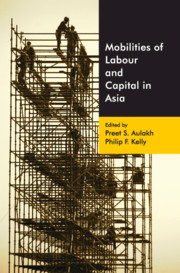Book contents
- Frontmatter
- Contents
- List of Figures
- List of Tables
- List of Appendices
- Acknowledgements
- 1 Introduction: Conceptualizing Labour and Capital Mobilities In and Out of Asia
- SECTION I From Capital to Labour Mobility
- SECTION II From Labour to Capital Mobility
- 7 Skills Development Initiatives and Labour Migration in a Secondary Circuit of Globalized Production: Evidence from the Garment Industry in India
- 8 The Counter Geographies of Globalization: Women's Labour Migration along the Nepal–Persian Gulf Migratory Corridor
- 9 Migration and Developmental Capital in a Punjab Village
- 10 The Production of Nurses for Global Markets: Tracing Capital and Labour Circulation In and Out of Asia
- 11 The Mobility–Oligopoly Nexus in Philippine Property Development
- Notes on Contributors
- Index
7 - Skills Development Initiatives and Labour Migration in a Secondary Circuit of Globalized Production: Evidence from the Garment Industry in India
from SECTION II - From Labour to Capital Mobility
Published online by Cambridge University Press: 24 December 2019
- Frontmatter
- Contents
- List of Figures
- List of Tables
- List of Appendices
- Acknowledgements
- 1 Introduction: Conceptualizing Labour and Capital Mobilities In and Out of Asia
- SECTION I From Capital to Labour Mobility
- SECTION II From Labour to Capital Mobility
- 7 Skills Development Initiatives and Labour Migration in a Secondary Circuit of Globalized Production: Evidence from the Garment Industry in India
- 8 The Counter Geographies of Globalization: Women's Labour Migration along the Nepal–Persian Gulf Migratory Corridor
- 9 Migration and Developmental Capital in a Punjab Village
- 10 The Production of Nurses for Global Markets: Tracing Capital and Labour Circulation In and Out of Asia
- 11 The Mobility–Oligopoly Nexus in Philippine Property Development
- Notes on Contributors
- Index
Summary
Introduction
Global circuits strategically organize production processes across new sites through the conjoint actions of a set of actors such as firms, cities, states, and other sectors (Beaverstock et al., 2002). These actors perform important functions in production circuits and shape the geographies of capital and labour at global, national, and subnational scales. A city centre becomes a critical node in the circuits of production by facilitating an environment for the consolidation of hyper-mobile capital and for the provisioning of skilled labour, depending on its strategic positioning and its partnership with other actors. The highly specialized cross-border circuits corresponding to specific industries, more precisely those components of industries that are operating across national borders, connect a series of cities embedded within a nation to the global city network (Sassen, 2001). Therefore, the opening up of economies to the global market and the increasingly interconnected space of flows of labour, capital, knowledge, and goods have secondary consequences within a nation. At the same time, the relentless search for new sites of production and service activities across borders by the new transnational lead firms reproduces more globally integrated and sophisticated production networks by consolidating capital and labour for value creation under different systems of production and by promoting regional development through strategic partnerships between actors (Coe et al., 2010; Coe and Hess, 2013).
Therefore, the global production networks framework calls for a dynamic approach to understand the complex and evolutionary nature of the relationship between state and firm as well as the relationship between fluidity and fixity of both labour and capital (Rainnie, Herod, and McGrath-Champ, 2011; Yeung, 2013). This framework also recognizes the inevitable linkages of households, enterprises, and states to one another in the circuits of production (Gereffi, Korzeniewicz, and Korzeniewicz, 1994; Coe and Yeung, 2015) and provides helpful insights into investigating the capital–labour dynamics and the spatialities of new sites of production within a nation. In this context, this chapter attempts to integrate the study of the concentration of capital in urban spaces and the mobility of labour from rural to urban areas in India. The chapter illustrates how the garment production circuit connects a series of urban spaces with their rural counterparts by examining the consolidation of capital and mobilities of labour, with a particular focus on the institutional governance and the socio-economic and cultural forces influencing labour mobility within India.
- Type
- Chapter
- Information
- Mobilities of Labour and Capital in Asia , pp. 153 - 171Publisher: Cambridge University PressPrint publication year: 2020
- 1
- Cited by



